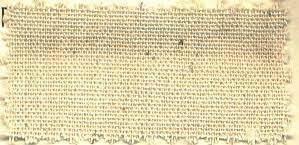Loom Weaving:
The making of cloth dates back thousands of years starting with coarse fabrics from grasses and leaves. A fine string or thread was made by twisting together and stretching out handfuls of plant fibers. With this development came the beginning of spinning, weaving, and hand stitching.
Weaving first started with narrow bands that were woven by hand, followed by the progression to loom weaving. Going as far back as ancient Egypt, weaving linen and spinning thread were important for personal household use and a source of income. Early American immigrants were known to weave. However, the Crusaders were first credited with introducing Europeans to the technique.
Materials: Your kit contains a hand loom, a shuttle and weaving thread. You might also need scissors and a yardstick or ruler for measuring and cutting. A darning needle is useful for hiding ends and adding beads. Use warp and weft material of appropriate weight for the frame and project. Jute and cotton yarn make great warp material as they do not stretch.
The definition of weaving is the interlacing of fibers together. In making fabric this is usually done by using one thread to go over and under another thread and is called a simple weave or basket weave pattern. Different patterns are made by how many weft threads, the threads used for weaving, are used to go under and over the warp, or the threads that are wrapped around the loom.
Weaving in China
In the 27th century B.C.E., during the reign of Emperor Huang-Ti, a disease began to destroy the trees in the royal mulberry grove, so the emperor asked his empress to study the problem. Empress Hsi-Ling-shi spent time in the groves and noticed that small white worms were devouring the mulberry leaves. The worms then would crawl to the naked stems below where they would spin silvery, white cocoons. According to legend, Empress His-Ling-shi took some of the small cocoons to her apartment for closer observation, and there one of the cocoons accidentally fell into a bath of warm water. As water was absorbed into the cocoon, the tiny pocket began to unravel revealing a delicate network of fibers. The empress pulled a small filament from the network and realized the fiber was a continuous thread, hundreds of feet long. In fact, one cocoon can contain a single filament measuring over 1,000 yards. With the discovery of the silk fiber, His-Ling-shi found the secret of acquiring a very rare and exquisite thread, one that could be used without first going through the spinning process.
As weavers in China began using silk in many of their elegant garments and tapestries, and later, as fabrics began to be exported, people outside of China became envious and somewhat resentful of the discovery. Despite the interest and curiosity of others, the process of cultivating silk remained a mystery and a well-kept secret to the outside world for over 3000 years.
The hand loom in our kit is portable and great for small hands, as well as being easy to use. Extra weaving materials and a shuttle, to carry yarn for weaving, are included.
Bookmarks and bracelets are quick and fun projects. Strips can be sewn together for many more uses. Beaded items can be made by threading beads onto the weaving yarn and using a needle with an eye small enough to fit through the holes. Large diameter seed or pony beads make beautiful bracelets
Weaving in Egypt
Sealed tombs in Egypt's Nile Valley have brought forth fabrics dating back as far as 5000 BC. The predominant fiber found in Egypt was linen, a product of the native flax plant. A simple plain-weave pattern, an over-under stitch, was used for the construction of cloth. This plain weave structure was the dominant stitch until about 2500 BC. Wool was accessible in Egypt, as well, but was considered a fiber of the lower classes, namely, herdsmen and farmers.
Wool garments are rarely found in Egyptian tombs. In fact, Egyptian law placed certain restrictions on the use of wool. One such law forbade members of the priesthood to wear wool next to their skin or to wear wool into a place of worship. Cloth make from wool was thought to be crude and irreverent. Fabric made with cotton was much more acceptable and has been found in Egyptian tombs, but cloth made with linen was always considered the highest quality material and was used in mummy wrappings of the aristocracy.
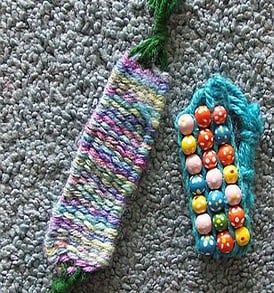

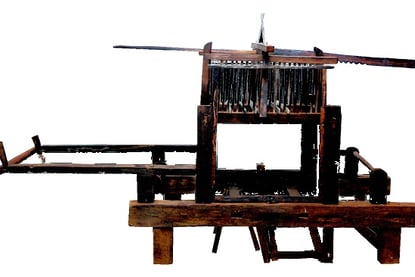

Pattern loom excavated from the Lijashan Site in Jiangchuan.
Western Han Dyanasty (206 BCE-8CE) China Silk Museum.
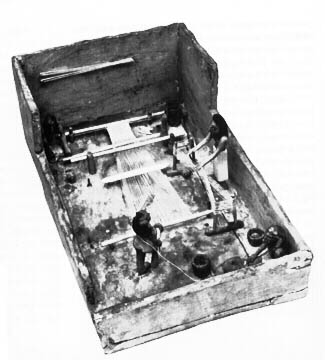

This model contains a horizontal loom or pit loom, warping devices and other tools, and weavers in action. We can also take note of the garments worn by the people.
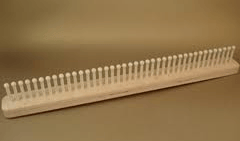



It is thought a two row peg loom was used to make the tunic similar to what Christ wore.
Osnaburg Weaving
Its origins began in Osnabruck, Germany, date uncertain, for which the fabric was named. It was a coarse, strong, plain-weave tow linen often left in its natural color. Fabric might have been similar to or a type of canvas, dowlas or sackcloth, all coarse linens used for cloak bags and cases and clothing for lower classes in the 16th and 17th centuries.
Today's name and spelling is due to the English corruption of Osnaburg but in former days it was also spelled Osenbreges, Ossenbrydge, Ostenbriges, Ozenbridg[e], Osburow, Osenbrigs, Oz- Osnabrigs -brug, Ozenbrigs, Ossenburgs and Osnaburgh.
Modern osnaburgs are coarse-yarn, medium and heavy weight cloths of low construction made of [1] part-waste cotton mixed with low-grade cotton called PW osnaburgs and [2] all short-staple white cotton low-grade stock called clean osnaburgs. Thread count ranges from 20x20 to 40x40.
Up until the mid-1800s, storage containers were primarily wooden barrels, boxes, tins and to some extent, pottery. It was the abundant source of cotton from the South which enabled the transformation to cotton bags for flour, sugar, meal, grain, salt and feed. Eventually this led to the births of industries for weaving bag cloth, manufacturing bags and developing inks suitable for printing on textiles, not to mention those handy with words to come up with catchy advertising .
Osnaburg canvas was a coarse, unbleached tow linen cloth first made in Osnabrück, Germany. It was commonly used for trousers and sacking. The unprocessed quality of the fabric made it affordable for clothing servants, slaves and others of the lower orders.
It was also specified in the 1730s Admiralty Slop Contracts (for Sailors' Clothing) as fabric for trousers and frocks thus:
Trousers of Brown Osnaburgh Canvas, cut out of whole cloth, breeches fashion, 2 buttons to the waistband and 2 others.
Canvas Frocks made of the best Osnaburgh Canvas, with 3 buttons at the breast, and 2 at the wrist
(Like many fabrics, in the 19th century Osnaburg came to be made out of cotton and it changed radically in character.)
Coarse carded osnaburg of part waste cotton, 40" wide, in its grey or unconverted state. When converted it will be used for bags, decorative fabrics, women's and children's apparel. - National Cotton Council
Lighter weight carded sheeting osnaburg, 37" wide, in grey state which will be converted to bags and other industrial fabrics such as crinoline and filter cloth. - National Cotton Council
Magnification of slub-yarn osnaburg in grey state, 38" wide. - Staple Cotton Fabrics, 1942

